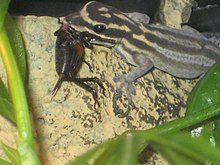Lygodactylus
| Lygodactylus | ||||||||||||
|---|---|---|---|---|---|---|---|---|---|---|---|---|

Yellow-headed dwarf gecko ( Lygodactylus picturatus ) |
||||||||||||
| Systematics | ||||||||||||
|
||||||||||||
| Scientific name | ||||||||||||
| Lygodactylus | ||||||||||||
| Gray , 1864 |
The genus Lygodactylus , which includes about 60 species, all of which, like the genera Phelsuma and Sphaerodactylus , are diurnal, belongs to the gecko family (Gekkonidae). The small geckos, which are also called "dwarf geckos", as adults, only reach total lengths of four to a maximum of nine centimeters.
The lizards are mainly found in Africa and Madagascar , but there are also two species in South America .
Lygodactylus picturatus
The yellow-headed dwarf gecko ( L. picturatus ), which is probably one of the best-known geckos of this genus in domestic terrariums , occurs in the coastal area of East Africa and is a pure tree inhabitant. The males of this species are slightly larger than the females and are much more conspicuously colored. While the females have a beige-gray body color with scattered spots, the body of the males is blue-gray with a bright yellow head (see illustration).
Lygodactylus kimhowelli
Lygodactylus kimhowelli is the scientific name. There are several competing German names, but they are not unambiguous (including yellow-headed day gecko, yellow-headed sticky-tailed gecko or dwarf-striped gecko).
The animals are a good seven centimeters long and can usually be kept in pairs without any problems. Best in terrariums with a minimum size of 30 × 30 centimeters (L × W) in the base area, the height is variable. Males and females are distinguished by the color of the throat (males black, females striped gray). In the terrarium, a moderately humid climate (25–30 ° C, 40–60% [during the day] to 80% [at night] relative humidity) is preferred. Small insects are eaten (crickets, spiders, crickets; approx. Six to eight prey every two days) and as an extra every now and then fruit pulp (banana pulp, ready-to-eat food for children, etc.).
species
- Lygodactylus angolensis Bocage, 1896
- Lygodactylus angularis Günther, 1893
- Lygodactylus arnoulti Pasteur, 1964
- Lygodactylus bernardi FitzSimons, 1958
- Lygodactylus blancae Pasteur, 1995
- Lygodactylus blanci Pasteur, 1967
- Lygodactylus bradfieldi Hewitt, 1932
- Lygodactylus broadleyi Pasteur, 1995
- Lygodactylus capensis Smith, 1849
- Lygodactylus chobiensis Fitzsimons, 1932
- Lygodactylus conradti Matschie, 1892
- Lygodactylus conraui Tornier, 1902
- Lygodactylus decaryi Angel, 1930
- Lygodactylus depressus Schmidt, 1919
- Lygodactylus expectatus Pasteur & Blanc, 1967
- Lygodactylus fischeri Boulenger, 1890
- Lygodactylus grandisonae Pasteur, 1962
- Lygodactylus graniticolus Jacobsen, 1992
- Lygodactylus gravis Pasteur, 1964
- Lygodactylus guibei Pasteur, 1964
- Lygodactylus gutturalis (Bocage, 1873)
- Lygodactylus heterurus Boettger, 1913
- Lygodactylus howelli Pasteur & Broadley, 1988
- Lygodactylus inexpectatus Pasteur, 1964
- Lygodactylus insularis Boettger, 1913
- Lygodactylus intermedius Pasteur, 1995
- Lygodactylus keniensis Parker, 1936
- Lygodactylus kimhowelli Pasteur, 1995
- Lygodactylus klemmeri Pasteur, 1964
- Lygodactylus klugei Smith, Martin & Swain, 1977
- Lygodactylus lawrencei Hewitt, 1926
- Lygodactylus luteopicturatus Pasteur, 1964
- Lygodactylus madagascariensis Boettger, 1881
- Lygodactylus manni Loveridge, 1928
- Lygodactylus methueni Fitzsimons, 1937
- Lygodactylus miops Günther, 1891
- Lygodactylus mirabilis Pasteur, 1962
- Lygodactylus montanus Pasteur, 1964
- Lygodactylus nigropunctatus Jacobsen, 1992
- Lygodactylus ocellatus Roux, 1907
- Lygodactylus ornatus Pasteur, 1964
- Lygodactylus pauliani Pasteur & Blanc, 1991
- Lygodactylus picturatus (Peters, 1868)
- Lygodactylus pictus Peters, 1883
- Lygodactylus praecox Pasteur, 1995
- Lygodactylus rarus Pasteur & Blanc, 1973
- Lygodactylus rex Broadley, 1963
- Lygodactylus scheffleri Sternfeld, 1912
- Lygodactylus scorteccii Pasteur, 1959
- Lygodactylus septemtuberculatus Angel, 1942
- Lygodactylus somalicus Loveridge, 1935
- Lygodactylus stevensoni Hewitt, 1926
- Lygodactylus thomensis (Peters, 1881)
- Lygodactylus tolampyae (Grandidier, 1872)
- Lygodactylus tuberosus Mertens, 1965
- Lygodactylus verticillatus Mocquard, 1895
- Lygodactylus waterbergensis Jacobsen, 1992
- Lygodactylus wetzeli Smith, Martin & Swain, 1977
- Lygodactylus williamsi Loveridge, 1952
literature
- Beate Röll: Dwarf geckos, Lygodactylus , NTV Natur and Tier-Verlag Münster, 2004, ISBN 3-937285-16-4 .
